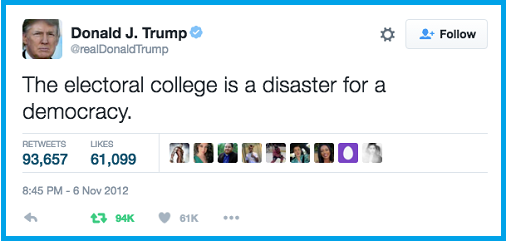Electoral College
Shouldn't all elections adhere to the principle of "one person one vote"? In some states, one person's vote could be worth many times more than the vote of a person from another state.
Yes, the electoral college certainly gives the smaller-populated states an "edge" over the larger-populated ones. Perhaps this is too much of an advantage?
So, now the question is, does the electoral college system require changing or perhaps even total elimination?
To see US Presidential elections in which candidates won the popular vote but lost the electoral vote, click here.
Congressional Representatives are apportioned by the population of each state but since every state has 2 Senators (regardless of population), this would give states with smaller populations a chance to compete with higher-populated states.
Let's see precisely how this works.
Comparing Wyoming to California, the calculations are:
State Population Reps Population Per
Representative Wyoming 568,300 1 568,300 California 37,341,998 53 704,566
That seems (roughly speaking) to be a fair and equal representation.
Let's look at Wyoming and California again.
State Population Electoral
Votes Population Per
Electoral Vote Wyoming 568,300 3 189,433 California 37,341,998 55 678,945
Looking at the chart below, we see that the ten least-populated states have between 2 to 3½ times more voting power than California!
State Population
Rank Population Electoral
Votes Population Per
Electoral Vote Electoral
VotingPower
ComparedTo
California Wyoming 50 568,300 3 189,433 3.58 District of Columbia *** 601,723 3 200,574 3.39 Vermont 49 630,337 3 210,112 3.23 North Dakota 48 675,905 3 225,302 3.01 Alaska 47 721,523 3 240,508 2.82 Rhode Island 43 1,055,248 4 263,812 2.57 South Dakota 46 819,761 3 273,254 2.48 Delaware 45 900,877 3 300,292 2.26 New Hampshire 42 1,321,446 4 330,362 2.06 Montana 44 994,416 3 331,472 2.05 Maine 41 1,333,074 4 333,269 2.04 Hawaii 40 1,366,862 4 341,716 1.99 Nebraska 38 1,831,824 5 366,365 1.85 West Virginia 37 1,859,814 5 371,963 1.83 Idaho 39 1,573,500 4 393,375 1.73 New Mexico 36 2,067,273 5 413,455 1.64 Nevada 35 2,709,432 6 451,572 1.50 Utah 34 2,770,764 6 461,794 1.47 Kansas 33 2,863,812 6 477,302 1.42 Arkansas 32 2,926,228 6 487,705 1.39 Mississippi 31 2,978,240 6 496,373 1.37 Connecticut 29 3,581,630 7 511,661 1.33 Iowa 30 3,053,788 6 508,965 1.33 South Carolina 24 4,645,977 9 516,220 1.32 Minnesota 21 5,314,880 10 531,488 1.28 Alabama 23 4,802,980 9 533,664 1.27 Oklahoma 28 3,764,880 7 537,840 1.26 Kentucky 26 4,350,606 8 543,826 1.25 Oregon 27 3,848,605 7 549,801 1.23 Washington 13 6,753,370 12 562,781 1.21 Colorado 22 5,044,928 9 560,548 1.21 Wisconsin 20 5,698,232 10 569,823 1.19 Louisiana 25 4,553,964 8 569,246 1.19 Tennessee 17 6,375,429 11 579,584 1.17 Maryland 19 5,789,928 10 578,993 1.17 Arizona 16 6,412,698 11 582,973 1.16 Indiana 15 6,501,582 11 591,053 1.15 Massachusetts 14 6,559,641 11 596,331 1.14 Missouri 18 6,011,480 10 601148 1.13 Georgia 09 9,727,564 16 607,973 1.12 Michigan 08 9,911,622 16 619,476 1.10 Virginia 12 8,037,733 13 618,287 1.10 New Jersey 11 8,807,496 14 629,107 1.08 Pennsylvania 06 12,734,910 20 636,746 1.07 Illinois 05 12,864,384 20 643,219 1.06 Ohio 07 11,568,496 18 642,694 1.06 North Carolina 10 9,565,777 15 637,718 1.06 Florida 04 18,900,783 29 651,751 1.04 Texas 02 25,268,436 38 664,959 1.02 New York 03 19,421,046 29 669,691 1.01 California 01 37,341,998 55 678,945 1.00 

Copyright © 1999 - 1728 Software Systems